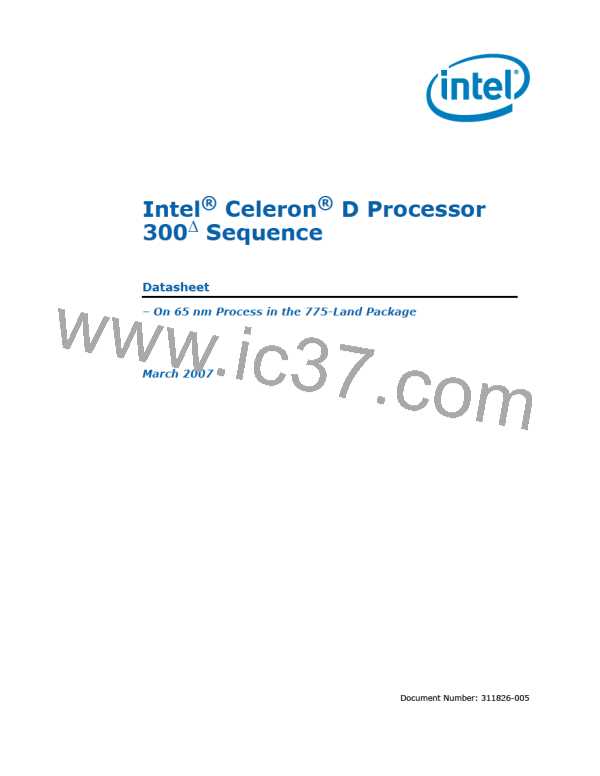Electrical Specifications
2.2.2
V Decoupling
TT
Decoupling must be provided on the motherboard. Decoupling solutions must be sized
to meet the expected load. To insure compliance with the specifications, various factors
associated with the power delivery solution must be considered including regulator
type, power plane and trace sizing, and component placement. A conservative
decoupling solution would consist of a combination of low ESR bulk capacitors and high
frequency ceramic capacitors.
2.2.3
FSB Decoupling
The processor integrates signal termination on the die. In addition, some of the high
frequency capacitance required for the FSB is included on the processor package.
However, additional high frequency capacitance must be added to the motherboard to
properly decouple the return currents from the front side bus. Bulk decoupling must
also be provided by the motherboard for proper [A]GTL+ bus operation.
2.3
Voltage Identification
The Voltage Identification (VID) specification for the processor is defined by the Voltage
Regulator-Down (VRD) 10.1 Design Guide For Desktop and Transportable LGA775
Socket. The voltage set by the VID signals is the reference VR output voltage to be
delivered to the processor VCC lands (see Section 2.5.3 for VCC overshoot
specifications). Refer to Table 14 for the DC specifications for these signals. A minimum
voltage for each processor frequency is provided in Table 4.
Individual processor VID values may be calibrated during manufacturing such that two
devices at the same core speed may have different default VID settings. This is
reflected by the VID Range values provided in Table 4. Refer to the Intel® Celeron®
D
Processor 300 Sequence Specification Update for further details on specific valid core
frequency and VID values of the processor.
The processor uses 6 voltage identification signals, VID[5:0], to support automatic
selection of power supply voltages. Table 2 specifies the voltage level corresponding to
the state of VID[5:0]. A ‘1’ in this table refers to a high voltage level and a ‘0’ refers to
a low voltage level. If the processor socket is empty (VID[5:0] = x11111), or the
voltage regulation circuit cannot supply the voltage that is requested, it must disable
itself. Refer to the Voltage Regulator-Down (VRD) 10.1 Design Guide For Desktop and
Transportable LGA775 Socket for further details.
The processor provides the ability to operate while transitioning to an adjacent VID and
its associated processor core voltage (VCC). This will represent a DC shift in the load
line. Note that a low-to-high or high-to-low voltage state change may result in as many
VID transitions as necessary to reach the target core voltage. Transitions above the
specified VID are not permitted. Table 4 includes VID step sizes and DC shift ranges.
Minimum and maximum voltages must be maintained as shown in Table 5 and Figure 1
as measured across the VCC_SENSE and VSS_SENSE lands.
The VRM or VRD used must be capable of regulating its output to the value defined by
the new VID. DC specifications for dynamic VID transitions are included in Table 4, and
Table 5. Refer to the Voltage Regulator-Down (VRD) 10.1 Design Guide For Desktop
and Transportable LGA775 Socket for further details.
14
Datasheet

 INTEL [ INTEL ]
INTEL [ INTEL ]